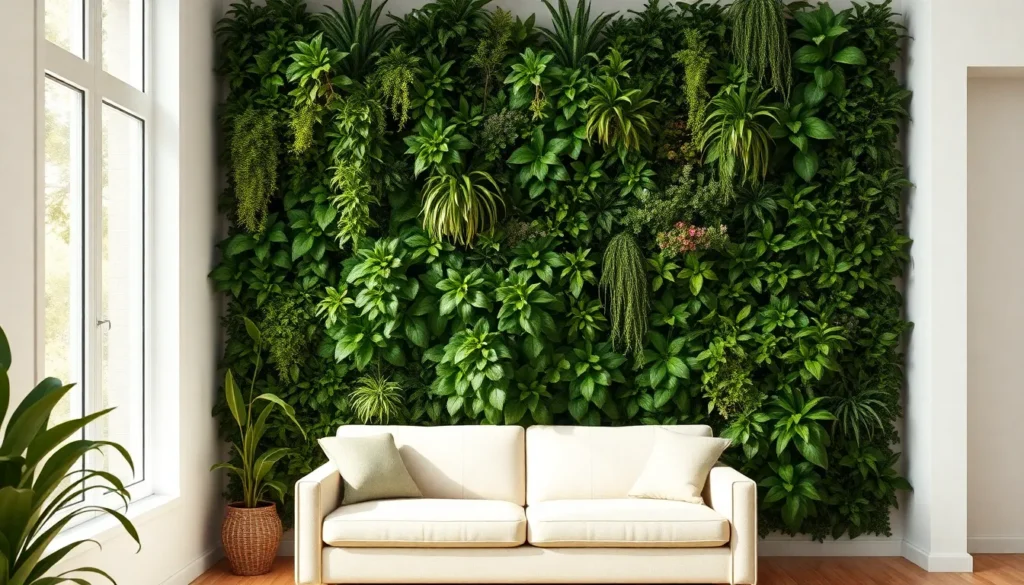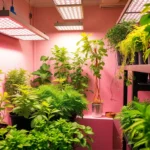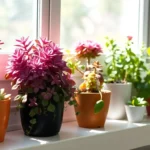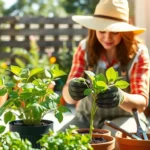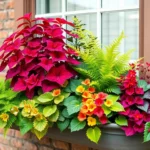We’ve all experienced that moment when we walk into a room and immediately feel something’s missing. The space feels cold or lifeless even though our best decorating efforts. That’s where an indoor plant wall transforms everything – turning bland walls into breathtaking living art that purifies our air while creating an Instagram-worthy focal point.
Creating a wall of plants indoor isn’t just about following the latest home decor trend. It’s about bringing nature’s calming energy into our daily lives while maximizing limited space. Whether we’re working with a tiny apartment or a spacious home office these vertical gardens offer endless possibilities for customization.
The best part? We don’t need a green thumb or expensive equipment to get started. From simple hanging planters to sophisticated hydroponic systems there’s an indoor plant wall solution that fits every budget and skill level. Let’s explore how we can transform our indoor spaces with these stunning vertical gardens.
Create a Living Green Backdrop With Vertical Garden Systems
Wall mounted vertical systems transform any bare wall into a stunning focal point that brings nature indoors. These modular frameworks offer the structural foundation we need to build impressive plant displays that maximize our growing space vertically.
Choose the Right Wall-Mounted Planter Framework
Modular pocket systems provide the most versatile foundation for creating expansive plant walls. These interlocking panels feature individual planting pockets that accommodate different plant sizes while maintaining clean lines across your wall surface. We recommend frameworks made from recycled felt or breathable fabric materials that promote healthy root development.
Grid based mounting systems offer maximum customization for our vertical gardens. These metal or wooden frameworks accept various planter attachments including hanging pots, wall planters, and climbing supports. Installation requires secure wall anchors rated for at least 50 pounds per square foot to handle the weight of saturated soil and mature plants.
Living wall panels create seamless green coverage when we want full wall transformation. Pre planted panels arrive ready to install and typically measure 12 to 24 inches square. These systems work best for decorative displays rather than productive gardens since plant selection remains limited to what suppliers offer.
Install Proper Drainage and Water Collection Systems
Drip trays prevent water damage by collecting excess moisture from each planting level. Position these removable trays beneath every row of planters to catch drainage water before it reaches your floors or walls. Stainless steel or heavy duty plastic trays resist corrosion and support easy cleaning maintenance.
Integrated water collection channels streamline drainage management in larger installations. These built in channels direct overflow water toward designated collection points rather than letting it drip randomly. Professional grade systems include pump mechanisms that recirculate collected water back through the irrigation network.
Wall protection barriers shield your surfaces from moisture penetration behind the planting system. Install waterproof membranes or plastic sheeting with proper vapor barriers to prevent mold growth and structural damage. Leave adequate air gaps between the barrier and wall surface to promote ventilation and prevent condensation buildup.
Select Appropriate Growing Medium for Wall Installations
Lightweight potting mixes reduce structural load while providing essential nutrients for healthy plant growth. Choose soilless blends containing peat moss, vermiculite, and perlite that weigh 40 to 60 percent less than traditional garden soil. These formulations retain moisture without becoming waterlogged in vertical applications.
Hydroponic growing media eliminate soil weight entirely while supporting robust plant development. Expanded clay pebbles, rockwool cubes, and coconut coir provide stable root anchoring with excellent drainage properties. We can reduce wall loading by up to 80 percent compared to soil based systems when using these inorganic substrates.
Custom soil amendments optimize growing conditions for exact plant requirements in our vertical gardens. Add slow release fertilizers, moisture retaining crystals, and beneficial mycorrhizal fungi to enhance plant performance. Mix these amendments at planting time since accessing individual pockets becomes difficult once our wall system reaches full maturity.
Design Your Indoor Plant Wall Layout for Maximum Visual Impact
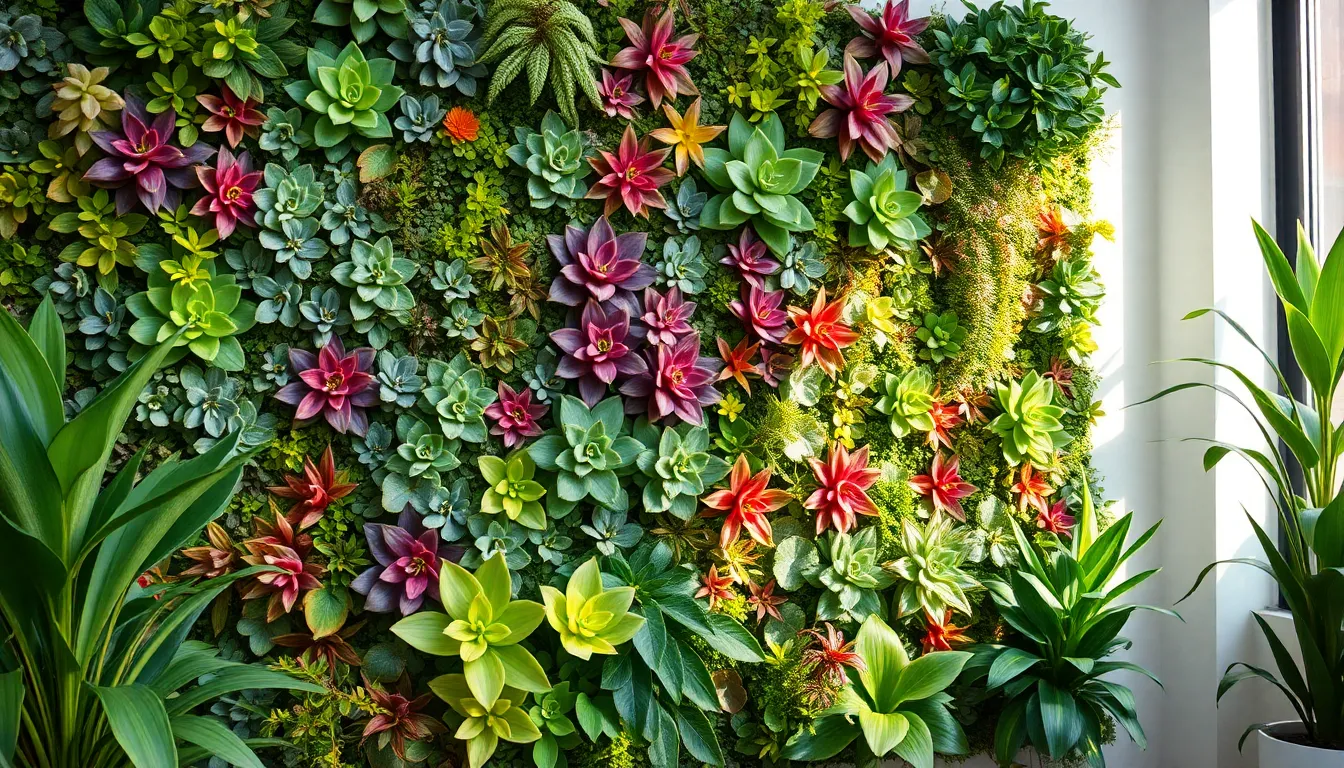
Creating a stunning indoor plant wall requires strategic planning and attention to visual composition. We’ll guide you through three essential design principles that’ll transform your vertical garden into a captivating focal point.
Plan Plant Placement Based on Light Requirements
Measuring your wall space first helps us determine the natural light patterns throughout the day. We need to group plants according to their sunlight needs to ensure healthy, even growth across our entire display.
Light-loving plants thrive in the brightest sections of our wall, while shade-tolerant varieties perform better in dimmer areas. Mixing high-light plants with low-light ones in the same zone creates uneven results, where one side wilts while the other flourishes.
Strategic placement examples:
- Position sun-loving succulents and herbs in south-facing wall sections
- Place pothos and snake plants in areas with indirect light
- Reserve north-facing or shadowed spots for peace lilies and ZZ plants
When natural light proves insufficient, we supplement with grow lights to maintain consistent illumination across our plant wall.
Create Texture Contrast With Different Leaf Shapes and Sizes
Incorporating diverse leaf textures adds visual depth and tactile appeal to our plant wall design. We achieve this contrast by combining plants with varying foliage characteristics.
Effective texture combinations:
- Pair broad-leaf plants like monstera with fine, feathery ferns
- Contrast large, glossy leaves with small, matte foliage
- Mix spiky succulents with rounded, soft leaves
- Balance dense, bushy plants with trailing varieties
This layering technique creates captivating focal points while preventing our wall from appearing flat or monotonous. Each plant’s unique texture contributes to the overall visual complexity of our vertical garden.
Incorporate Color Variation Through Foliage and Flowering Plants
Using diverse foliage colors throughout our plant wall prevents monotony and creates natural focal points. We select plants with varying leaf colors including deep greens, purples, reds, and variegated patterns.
Color variation strategies:
- Mix different green tones from lime to forest green
- Add purple plants like purple heart or coleus for depth
- Include variegated plants with white, cream, or yellow markings
- Incorporate red-toned plants like croton or red aglaonema
Flowering plants provide seasonal color bursts that highlight exact areas of our wall. We choose varieties that bloom indoors, such as African violets, begonias, or small orchids, to maintain year-round visual interest.
This thoughtful color planning ensures our indoor plant wall remains vibrant and visually captivating throughout all seasons.
Select the Best Plants for Your Wall of Plants Indoor Setup
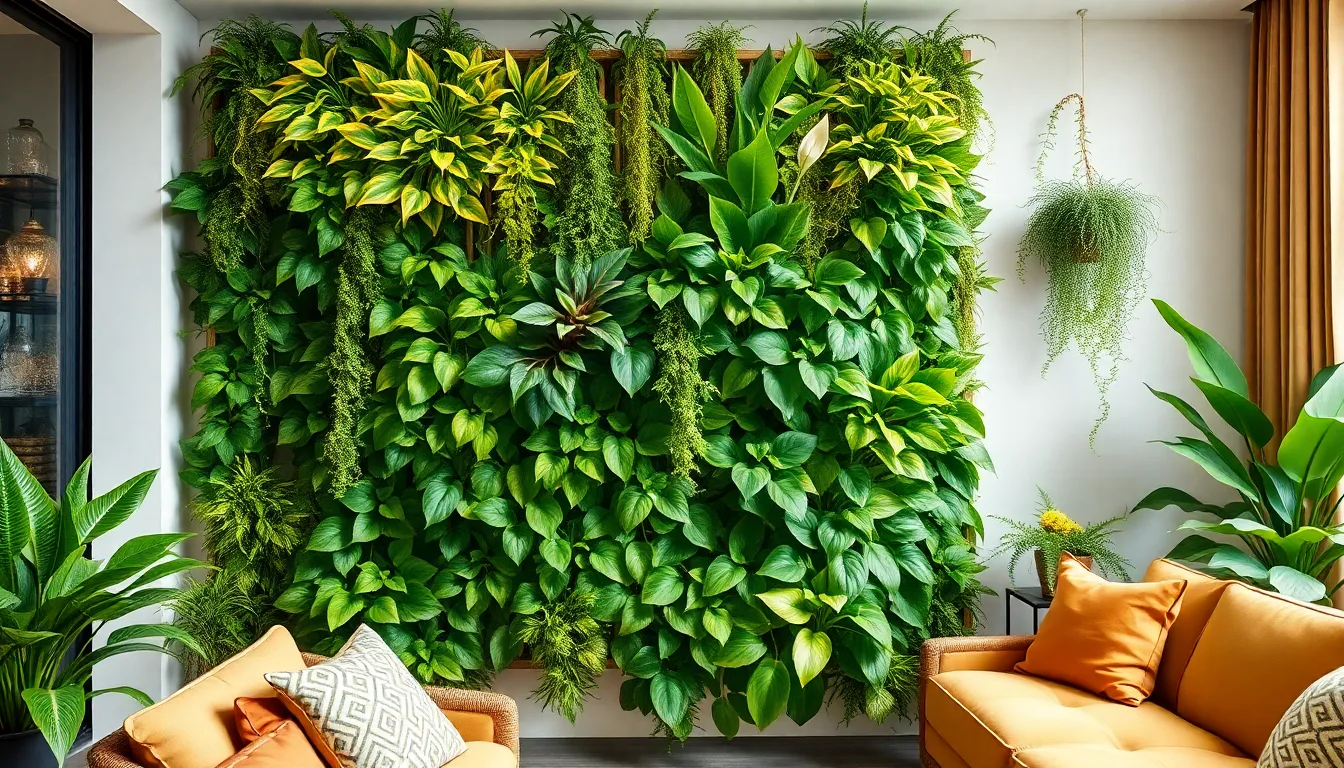
With your vertical garden system in place, choosing the right plants becomes crucial for creating a thriving indoor plant wall. We’ll guide you through selecting varieties that match your experience level, growth goals, and health benefits.
Low-Maintenance Options for Beginner Indoor Gardeners
Golden Pothos stands out as our top recommendation for first-time vertical gardeners. This resilient plant thrives in low light conditions and forgives irregular watering schedules, making it perfect for busy lifestyles. Its trailing vines create beautiful “living curtains” that cascade down your wall with minimal effort.
Sansevieria transforms your space with its striking architectural form while requiring almost no maintenance. Water only when the soil feels completely dry, and this hardy plant will continue growing steadily. Sansevieria Cylindrica works especially well in modern minimalist designs, growing tall to fill bottom sections of your wall.
Tillandsia and succulents offer stress-free gardening for those seeking ultra-low maintenance options. These drought-tolerant plants need watering just once or twice weekly and adapt well to various indoor conditions. Their unique textures and forms add visual interest without demanding constant attention.
Fast-Growing Species That Fill Space Quickly
Golden Pothos delivers rapid coverage with its fast-growing vines that quickly spread across vertical surfaces. Within months, these trailing stems create full, lush coverage that transforms bare walls into green focal points. The plant’s ability to grow both upward and downward makes it versatile for any wall configuration.
Boston Fern fills empty spaces with its dense, flowing fronds that add immediate volume to your vertical garden. These bright green plants create soft, cascading textures that make walls appear fuller faster than most other species. Their rapid growth means you’ll see noticeable progress within weeks of installation.
Philodendron family members expand quickly with their bold foliage and vigorous stems that adapt to vertical growing conditions. These hardy plants can climb upward or trail downward, allowing you to direct their growth to fill exact areas rapidly. Their large leaves create dramatic visual impact as they mature.
Air-Purifying Plants That Enhance Indoor Air Quality
Sansevieria removes harmful toxins from your indoor environment while requiring minimal care. Research shows this plant absorbs pollutants and continues purifying air even during nighttime hours. Its upright growth pattern makes it ideal for filling vertical spaces while improving your home’s air quality.
Peace Lily combines beauty with function through its attractive white blooms and proven air-filtering capabilities. This plant effectively removes common indoor toxins while adding elegant flowering elements to your wall. Its glossy green leaves create striking contrast against other plants in your vertical arrangement.
Boston Fern eliminates airborne pollutants while adding lush, natural beauty to your indoor space. Studies confirm this plant removes formaldehyde and other common household toxins from the air. Its dense fronds increase the surface area for air purification while creating a soft, organic backdrop.
Golden Pothos cleans indoor air while trailing gracefully down your wall with heart-shaped leaves. This versatile plant removes multiple indoor air pollutants including benzene and formaldehyde. Its rapid growth means more leaf surface area for air purification as your wall matures.
Install Essential Lighting Systems for Indoor Plant Wall Success
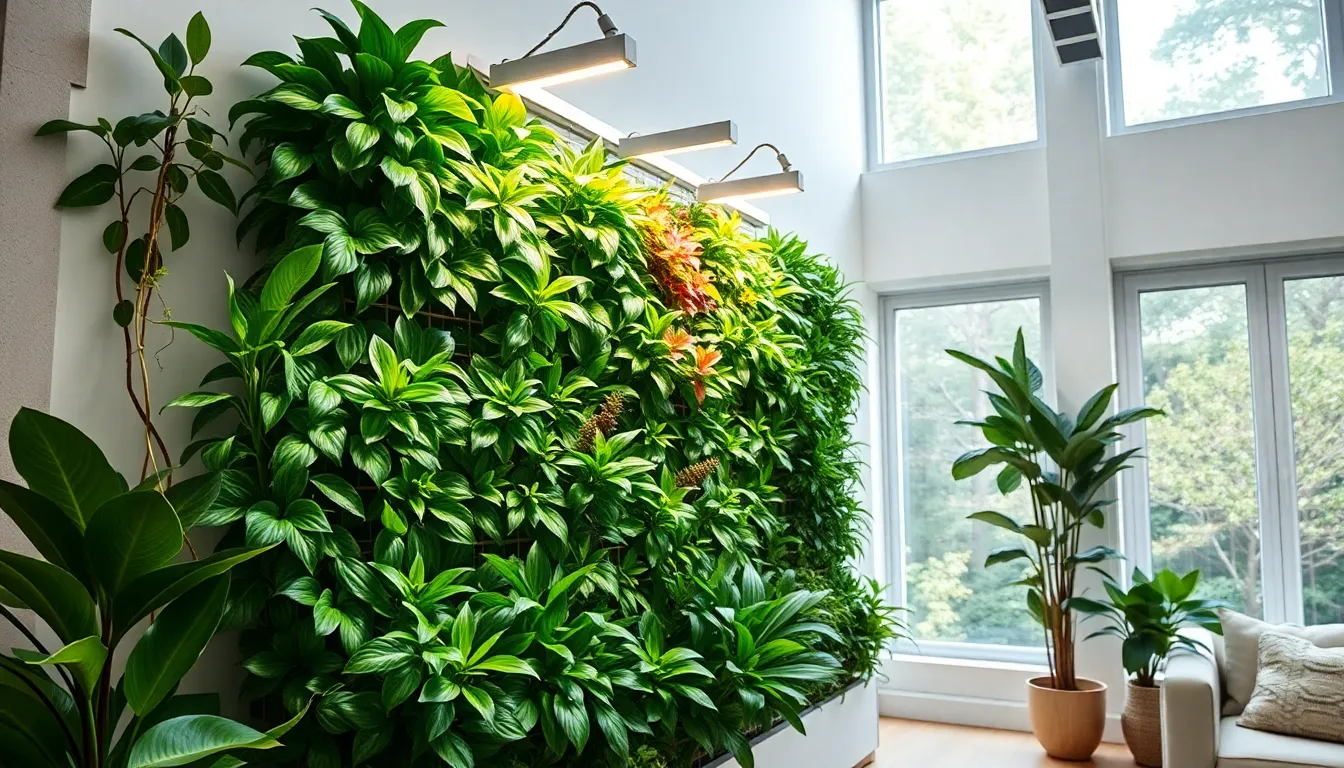
We’ll need to provide adequate lighting for our indoor plant wall since most interior spaces lack sufficient natural light for optimal plant growth. LED grow lights serve as the foundation of successful vertical gardens indoors.
LED Grow Light Placement and Positioning
Position LED grow lights above your plant wall at the correct distance to ensure even coverage across the entire surface. We recommend placing lights 6 to 24 inches away from plants depending on the light intensity and exact plant species we’re growing.
Angle the lights strategically to create uniform light distribution throughout the vertical garden. Multiple lights positioned at different points help eliminate shadows and dark spots that can stunt plant growth.
Install lights on adjustable mounting systems so we can modify the distance as plants mature and grow taller. This flexibility allows us to maintain optimal lighting conditions throughout the plant wall’s development.
Calculate Proper Light Duration and Intensity
Provide 12 to 16 hours of artificial light daily for most indoor plants to support healthy photosynthesis and growth. We can use programmable timers to maintain consistent lighting schedules without manual intervention.
Measure light intensity with a PAR meter to determine the photosynthetically active radiation reaching our plants. This scientific approach ensures we’re delivering the right amount of light energy for optimal plant health.
Balance intensity levels to support photosynthesis without causing leaf burn or stress. Different plant species require varying light intensities so we’ll need to group plants with similar lighting needs together.
Adjust lighting schedules seasonally to complement natural daylight patterns and reduce energy consumption during longer summer days.
Combine Natural and Artificial Light Sources Effectively
Position plant walls near windows whenever possible to take advantage of available natural sunlight throughout the day. This strategic placement reduces our reliance on artificial lighting and lowers energy costs.
Supplement natural light with LED grow lights during shorter winter days or in spaces with limited window access. We can create fuller light spectrums by combining both natural and artificial sources.
Use light sensors and smart controls to automatically adjust artificial lighting based on natural light availability. These systems optimize energy usage while maintaining consistent plant care standards.
Coordinate lighting schedules to provide seamless transitions between natural and artificial light sources throughout the day. This approach ensures plants receive adequate illumination regardless of weather conditions or seasonal changes.
Establish a Watering and Maintenance Routine for Wall Gardens
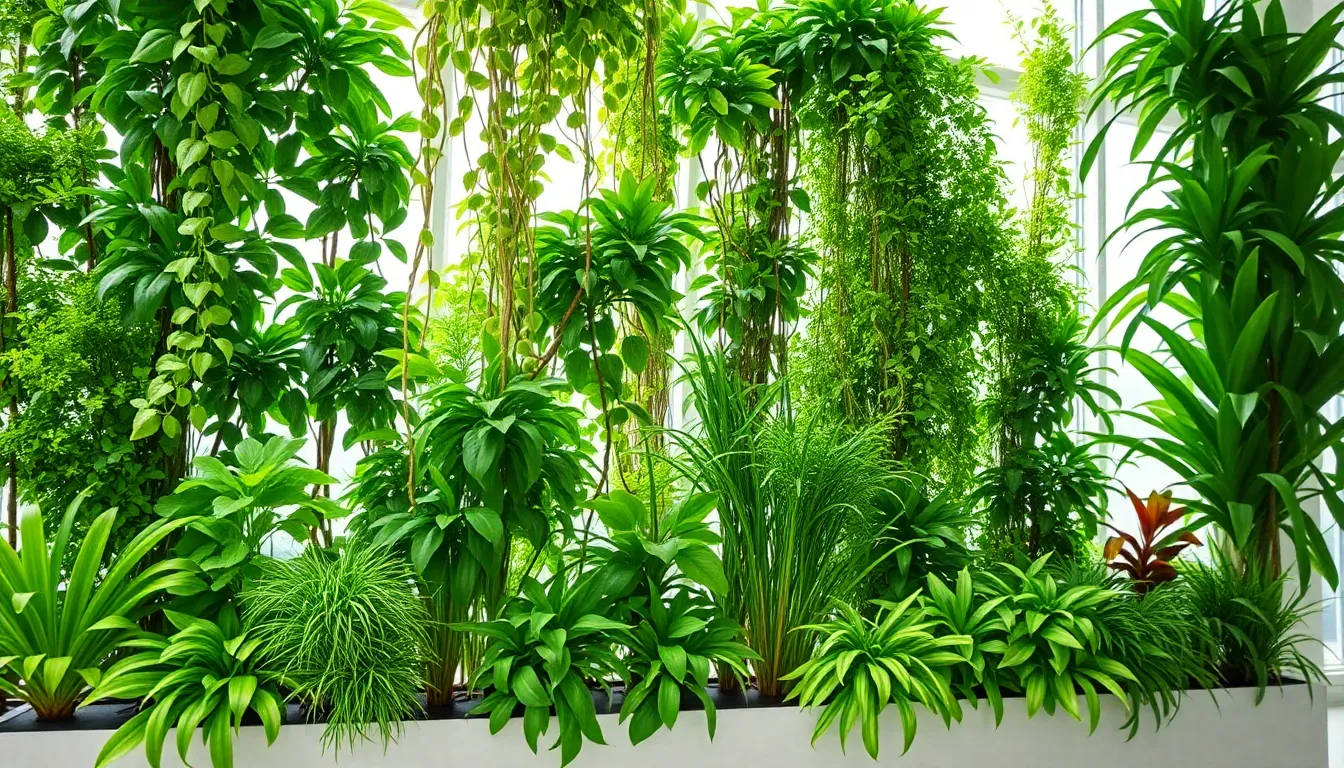
Proper watering and maintenance form the foundation of thriving indoor plant walls. Regular care ensures your vertical garden remains healthy and visually stunning year-round.
Set Up Automated Irrigation Systems
Automated drip irrigation systems provide consistent moisture delivery for your indoor plant wall. These programmable systems water plants at predetermined intervals, maintaining optimal soil moisture without oversaturation. Most systems can be set to deliver water every 1 to 2 weeks, though frequency varies based on plant types and environmental conditions.
Installing moisture meters helps you monitor the system’s effectiveness. Regular inspection prevents clogs, leaks, and malfunctions that could damage your plants or wall. We recommend checking irrigation lines monthly to ensure proper water flow reaches every section of your vertical garden.
Smart irrigation controllers offer precise timing control and can adjust watering schedules based on seasonal changes. These automated answers reduce maintenance time while providing more consistent care than manual watering methods.
Monitor Moisture Levels Across Different Wall Sections
Different sections of your plant wall experience varying light exposure and airflow patterns. Top sections often dry faster due to heat rising, while lower areas may retain moisture longer. Using moisture sensors throughout your wall helps identify these variations and prevents both dry spots and waterlogged conditions.
Digital moisture meters provide accurate readings for each plant pocket or section. Weekly monitoring allows you to adjust irrigation frequency based on exact zone requirements rather than treating the entire wall uniformly. Plants in brighter areas typically need more frequent watering than those in shadier spots.
Environmental factors like indoor humidity and air circulation affect moisture retention rates. Maintaining humidity levels between 40% and 80% supports optimal plant health while preventing moisture-related issues. We suggest creating a monitoring schedule to track these conditions consistently.
Prune and Replace Plants to Maintain Wall Appearance
Regular pruning maintains your wall’s visual appeal and promotes healthy plant growth. Removing brown, wilted, or dead leaves prevents disease spread and encourages new growth. Monthly pruning sessions keep plants properly sized and prevent overcrowding that blocks light from reaching lower plants.
Strategic trimming prevents fast-growing species from overwhelming slower-growing neighbors. Cut back overgrown plants that shade others, ensuring all plants receive adequate light exposure. This selective pruning maintains the balanced appearance you designed into your original layout.
Plant replacement becomes necessary when plants decline even though proper care. Seasonal changes, pest issues, or natural plant lifecycles may require swapping out individual plants. Keep backup plants ready for quick replacements to maintain your wall’s full appearance.
Fertilization supports continued growth and vibrant foliage color. Automated fertilizer systems can be integrated with irrigation systems for consistent nutrient delivery. Manual fertilization works well for smaller walls or when plants show exact nutrient deficiencies.
Address Common Challenges in Indoor Vertical Gardening
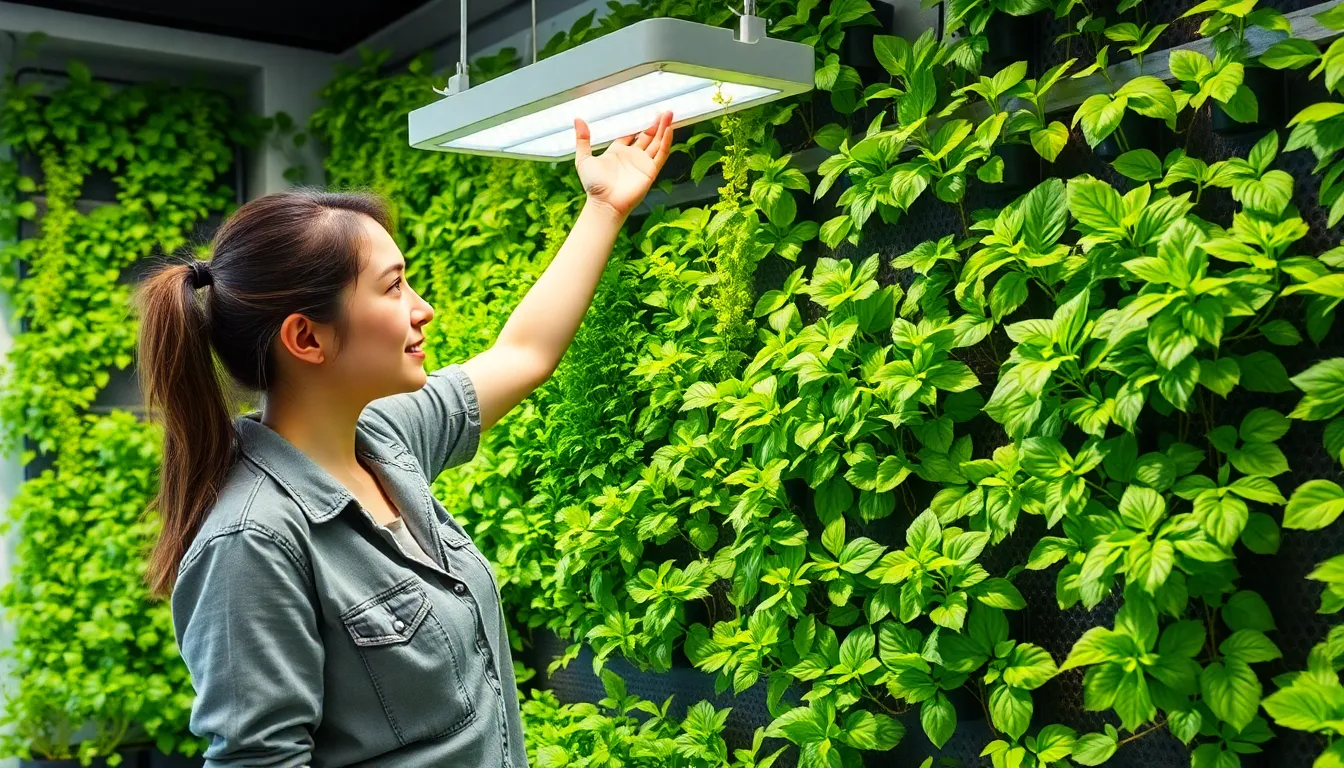
Creating a beautiful indoor plant wall brings unique challenges that we must tackle to ensure long-term success. Let’s explore the most common issues and their proven answers.
Prevent Water Damage to Walls and Flooring
Water damage ranks as the most serious threat to our indoor vertical gardens and home structures. Effective drainage systems serve as our first line of defense, incorporating grow mats, perforated trays, and capillary-wicking materials that control water flow and prevent free dripping onto floors and walls.
Sloped trays and gutters guide runoff toward plant roots on lower layers, eliminating water pooling that can cause structural damage. Many modern systems feature drainage collection linked to recirculation systems that filter and reuse water, preventing excess moisture accumulation near walls and floors.
Key Water Management Components:
| Component | Function | Benefit |
|---|---|---|
| Grow mats | Absorb excess moisture | Prevent dripping |
| Perforated trays | Control water distribution | Reduce pooling |
| Sloped gutters | Direct water flow | Protect flooring |
| Recirculation systems | Filter and reuse water | Minimize waste |
Manage Pest Control in Dense Plant Arrangements
Dense plant arrangements create microclimates that can harbor pests and diseases if we don’t manage them properly. Tightly packed plants trap moisture and reduce air circulation, creating ideal breeding conditions for unwanted insects and fungal issues.
Prevention strategies work better than reactive treatments in vertical gardens. We recommend maintaining good air circulation through strategic plant spacing and small fans when necessary. Regular inspection becomes crucial since early detection prevents pest populations from establishing in hard-to-reach areas.
Integrated pest management techniques include biological control agents and careful selection of pest-resistant plant species. Moisture management plays a vital role since stagnant water encourages pest development and disease spread throughout our vertical garden.
Solve Uneven Growth Patterns Across the Wall
Uneven plant growth creates an unsightly appearance and indicates problems with light exposure, nutrient distribution, or water supply across our vertical garden. Indoor environments lack consistent natural sunlight, making artificial lighting essential for uniform plant development.
LED lighting systems provide uniform light distribution when properly positioned and calibrated for our exact plant varieties. We can adjust light intensity and duration to match each plant’s requirements, ensuring consistent growth patterns from top to bottom.
Hydroponic and aeroponic systems enable precise control of nutrient delivery to each plant layer. Nutrient Film Technique and automated moving gutter systems ensure water and nutrients reach all plants evenly, minimizing growth disparities that create patchy appearances.
| Method | Application | Result |
|---|---|---|
| LED systems | Uniform light distribution | Consistent growth rates |
| Hydroponic delivery | Precise nutrient control | Balanced plant development |
| Automated irrigation | Even water distribution | Reduced growth variations |
| Moving gutter systems | Ever-changing nutrient flow | Optimal plant health |
Budget-Friendly DIY Solutions for Creating Plant Walls
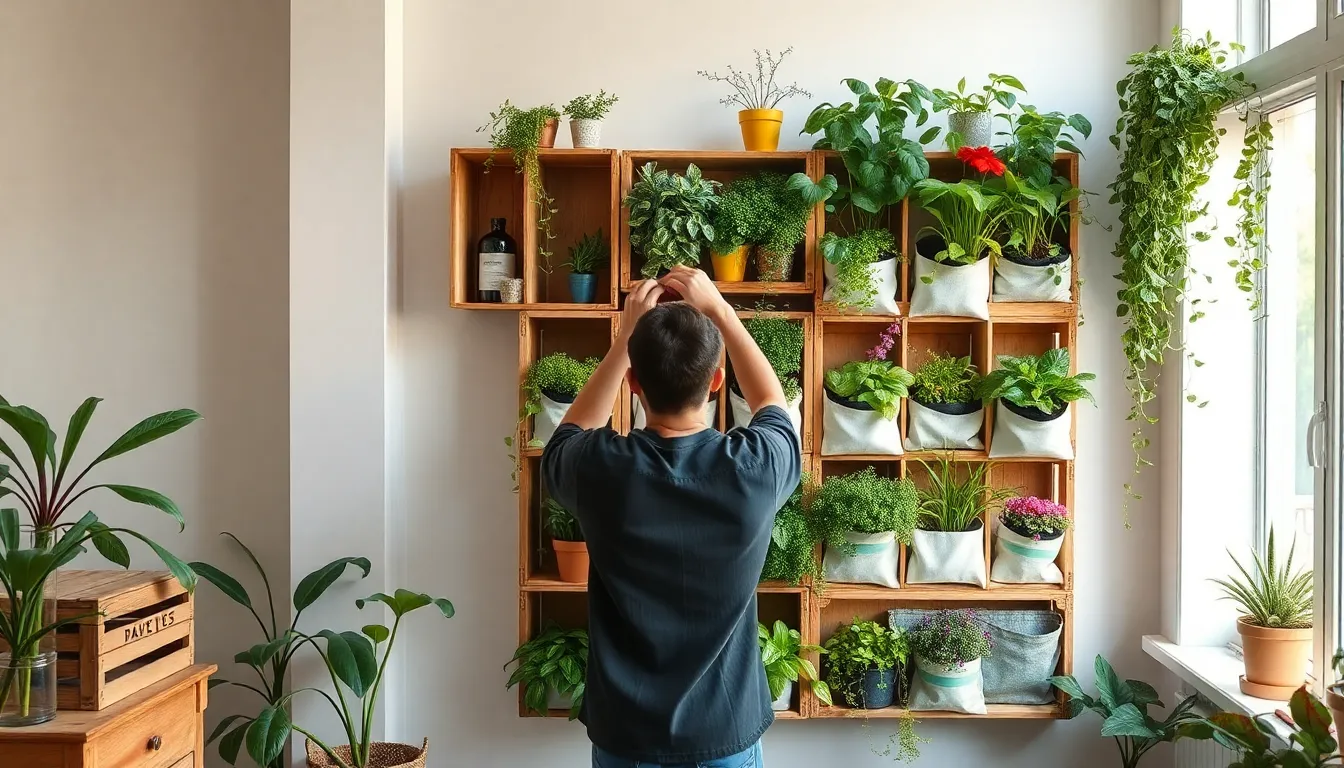
Creating stunning plant walls doesn’t require expensive commercial systems or professional installation. We’ve discovered many affordable methods that transform everyday materials into thriving vertical gardens.
Repurpose Household Items as Vertical Planters
Test tubes become elegant propagation stations when hung on angled nails throughout your wall space. We can fill these glass containers with water and root cuttings from pothos, philodendron, or other water-loving plants to create a minimalist living display. This method costs under $20 and provides continuous visual interest as roots develop and plants grow.
Ceiling tiles offer an unexpected foundation for self-watering green walls when we attach fabric pockets or small containers to their surface. We attach these tiles directly to walls and insert moisture-retaining systems that reduce daily maintenance requirements. Recycled plastic bottles, mason jars, and even old rain gutters can be mounted horizontally to create multiple planting levels without purchasing specialized equipment.
Old wooden crates stack vertically to form rustic planting towers that accommodate larger plants and trailing varieties. We position these containers at different angles to create ever-changing visual flow while maximizing our growing space efficiently.
Build Custom Wooden Frame Systems
Plywood sheets combined with 1×2 lumber boards create sturdy frameworks that support multiple plant containers at customized intervals. We can spray paint these frames in colors that complement our décor while maintaining structural integrity for heavier plant loads. This construction method allows us to design walls that fit exact dimensions and accommodate our preferred plant arrangements.
Wooden slat systems provide mounting points every few inches, giving us flexibility to adjust plant placement as our collection grows. We drill pilot holes at regular intervals and insert removable hooks or brackets that hold clay pots, hanging baskets, or custom planters. This approach costs approximately $30-50 per 4×6 foot section and supports plants weighing up to 30 pounds when properly anchored.
Frame systems also accommodate integrated watering answers like drip irrigation tubing or removable water collection trays. We can route these systems behind the wooden structure to maintain clean visual lines while ensuring proper drainage.
Use Pocket Planters and Hanging Answers
Fabric pocket planters create multiple growing spaces within compact vertical footprints, perfect for herbs, succulents, and small flowering plants. We hang these lightweight systems on standard wall hooks and fill each pocket with appropriate growing medium for different plant types. Canvas or leather versions withstand moisture better than synthetic materials and develop attractive patina over time.
Glass containers suspended at varying heights establish artistic propagation galleries that showcase root development and plant growth stages. We position these hanging elements near windows where natural light enhances the display while supporting healthy plant development. Small jars, test tubes, and repurposed glassware cost under $1 each and create sophisticated vertical arrangements.
Rope and macramé hanging systems support heavier planters while adding textural interest to our plant walls. We can create multi-tier arrangements that accommodate different plant sizes and growth habits, from cascading pothos to upright snake plants. These flexible systems adjust easily as plants mature and our design preferences evolve.
Transform Different Rooms With Strategic Plant Wall Placement
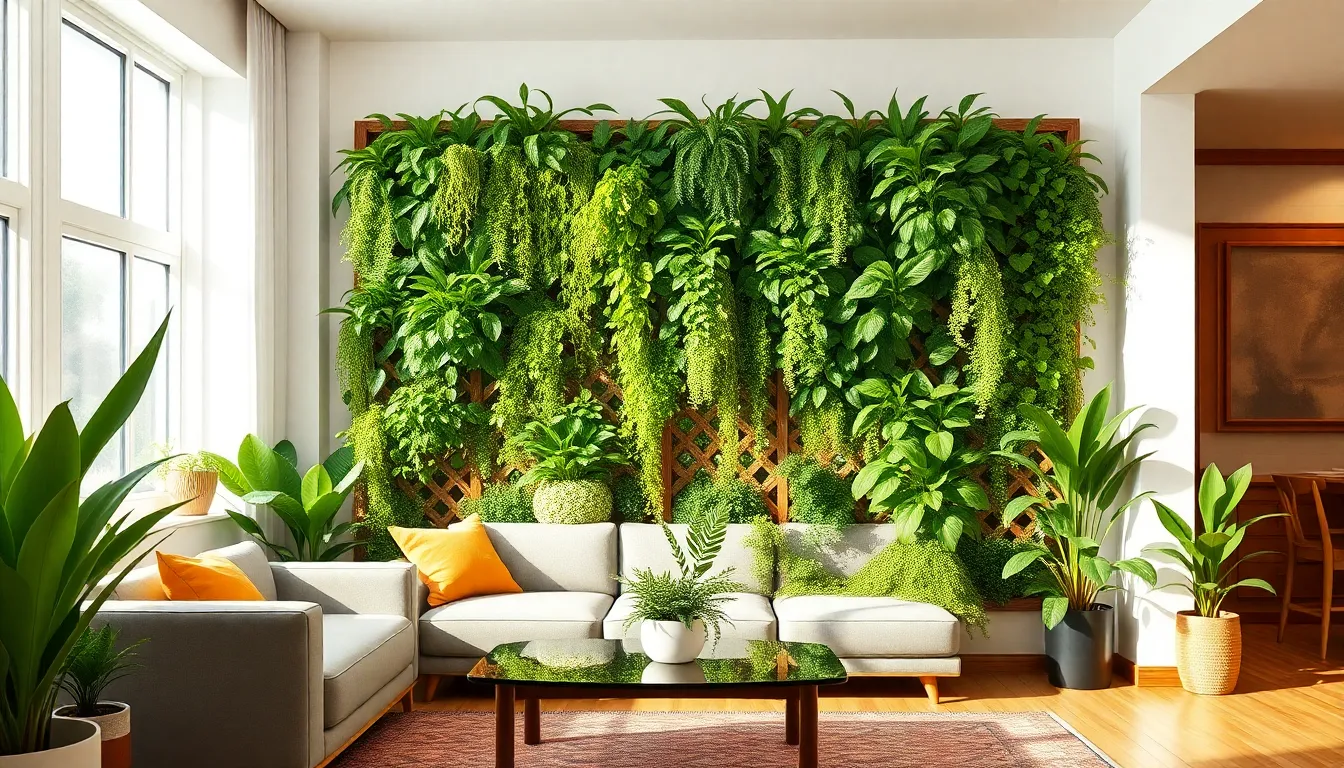
Creating room exact plant walls maximizes both aesthetic appeal and functional benefits throughout our homes. Strategic placement ensures each vertical garden thrives while serving its intended purpose.
Living Room Feature Wall Installations
Living room plant walls serve as stunning natural focal points that enliven spaces with lush greenery. Vertical planters mounted on lattice panels provide the perfect foundation for showcasing ornamental foliage that complements our existing decor style. We can create vibrant yet calming atmospheres by selecting plants that thrive in medium to bright indirect light conditions.
Mixed plant varieties add visual depth and seasonal interest to living room installations. Combining trailing plants like pothos with upright specimens such as snake plants creates ever-changing texture variations. Our feature walls become conversation starters while naturally purifying the air in spaces where we spend important time entertaining and relaxing.
Wall mounted systems protect our surfaces while supporting substantial plant collections. Using sturdy brackets secured to wall studs ensures our living room installations remain stable and safe. Plastic liners prevent moisture damage to underlying walls while maintaining the professional appearance we desire.
Kitchen Herb Wall Gardens
Kitchen herb walls provide fresh ingredients while saving valuable counter space for food preparation. Wall mounted terracotta pots or wooden planters with hooks create accessible growing systems for basil, thyme, rosemary, and parsley. These herbs elevate cooking flavors while remaining conveniently within reach during meal preparation.
Vertical herb gardens can be built simply using stained boards, brackets, and individual pots. Attaching mounting brackets directly to wall studs provides the structural support needed for multiple herb containers. Our DIY approach allows customization of spacing and plant selection based on cooking preferences and available wall space.
Indoor herb cultivation succeeds even without abundant natural sunlight in kitchen environments. Strategic placement near windows or under cabinet lighting ensures adequate growing conditions. We transform ordinary kitchen walls into functional gardens that make cooking more captivating and convenient while reducing grocery expenses.
Bathroom Humidity Loving Plant Displays
Bathroom environments offer ideal humidity and warmth conditions for moisture loving plants like ferns, orchids, and mosses. These naturally humid spaces eliminate the need for frequent misting or additional humidity sources. Our plant selections thrive in the steamy conditions created by daily showers and baths.
Mounted vertical planters near windows or light sources transform bathrooms into tropical style sanctuaries. Hanging systems work particularly well in smaller bathroom spaces where floor area is limited. We create spa like atmospheres while utilizing the existing moisture to maintain healthy plant growth.
Humidity loving plants improve indoor air quality while adding natural beauty to functional spaces. Bathroom plant walls help filter airborne toxins while creating calming environments for relaxation. Our strategic installations turn utilitarian rooms into refreshing retreats that showcase nature’s beauty.
Conclusion
We’ve explored the incredible industry of indoor plant walls and discovered they’re more accessible than ever before. Whether you’re working with a modest budget or ready to invest in premium systems your dream green wall is within reach.
The key to success lies in understanding your space lighting conditions and choosing the right plants for your lifestyle. With proper planning and the techniques we’ve shared you’ll create a stunning vertical garden that purifies your air and transforms your home.
Your indoor plant wall journey starts today. Take that first step choose your favorite room and begin building the green oasis you’ve always wanted. The rewards of cleaner air improved wellness and natural beauty are waiting for you.
Frequently Asked Questions
What is an indoor plant wall?
An indoor plant wall is a vertical garden system that allows you to grow plants on walls inside your home. These living installations can range from simple hanging planters to sophisticated hydroponic systems, creating beautiful green backdrops while purifying the air and enhancing your living space’s ambiance.
How much does it cost to create an indoor plant wall?
Indoor plant walls can fit various budgets. DIY options using repurposed materials like test tubes or ceiling tiles can cost under $50, while modular pocket systems range from $100-300. Professional hydroponic systems can cost $500-2000+, but there are affordable solutions for every skill level and budget.
What plants work best for indoor vertical gardens?
Low-maintenance plants are ideal for beginners, including pothos, spider plants, and snake plants. Air-purifying options like peace lilies and rubber plants offer additional benefits. Choose plants based on your wall’s light conditions and consider mixing different textures and colors for visual appeal.
How do I prevent water damage from my plant wall?
Install proper drainage systems with collection trays at the bottom of your wall. Use wall protection barriers like plastic sheeting or waterproof membranes behind the plants. Ensure good air circulation and avoid overwatering by implementing drip irrigation or automated watering systems.
What lighting do indoor plant walls need?
Most indoor plant walls require supplemental lighting since natural light is often insufficient. LED grow lights are recommended for their energy efficiency and low heat output. Position lights 12-18 inches from plants and provide 12-16 hours of light daily for optimal growth.
How often should I water my vertical garden?
Watering frequency depends on plant types, growing medium, and environmental conditions. Generally, check soil moisture every 2-3 days. Automated irrigation systems provide consistent watering, while manual watering allows better control. Avoid overwatering, which is more harmful than slight underwatering.
Can I create a plant wall without expensive equipment?
Yes! DIY solutions using everyday materials work excellently. Build wooden frame systems, repurpose household items as planters, use pocket organizers, or create hanging displays. These budget-friendly approaches can create stunning vertical gardens without commercial systems or professional installation.
Which rooms are best for indoor plant walls?
Living rooms benefit from feature walls that serve as natural focal points. Kitchens are perfect for herb walls that save counter space. Bathrooms work well for humidity-loving plants. Consider each room’s lighting, humidity, and space when choosing the location for your vertical garden.
How do I maintain my indoor plant wall?
Regular maintenance includes checking for pests, pruning overgrown plants, and monitoring water levels. Clean leaves monthly to ensure proper photosynthesis. Replace any dead or diseased plants promptly. Fertilize according to plant needs, typically every 2-4 weeks during growing season.
What are common problems with indoor plant walls?
Common issues include overwatering leading to root rot, inadequate lighting causing leggy growth, and pest infestations in humid conditions. Uneven growth patterns and water damage are also concerns. Proper planning, drainage systems, and regular monitoring help prevent these problems.

